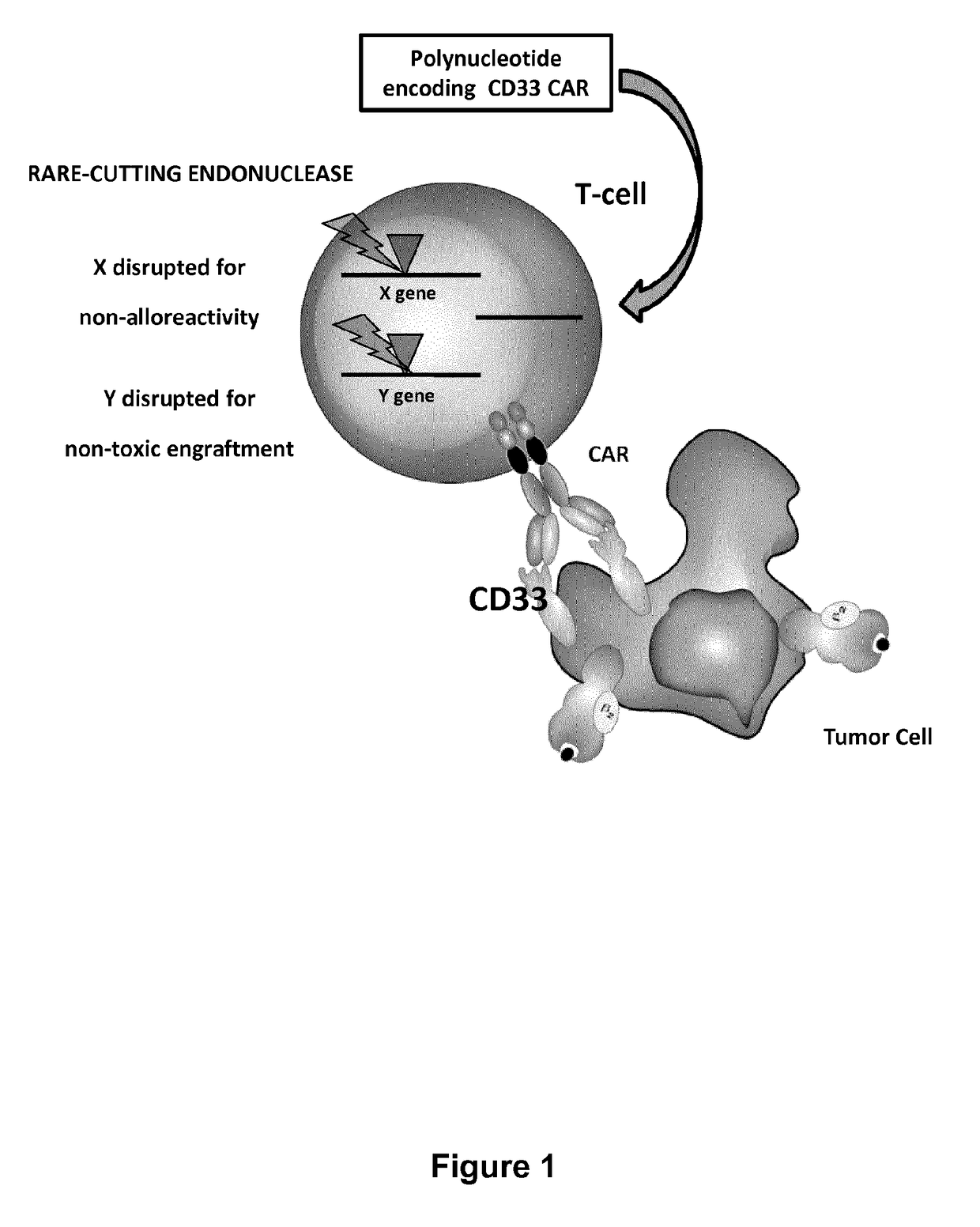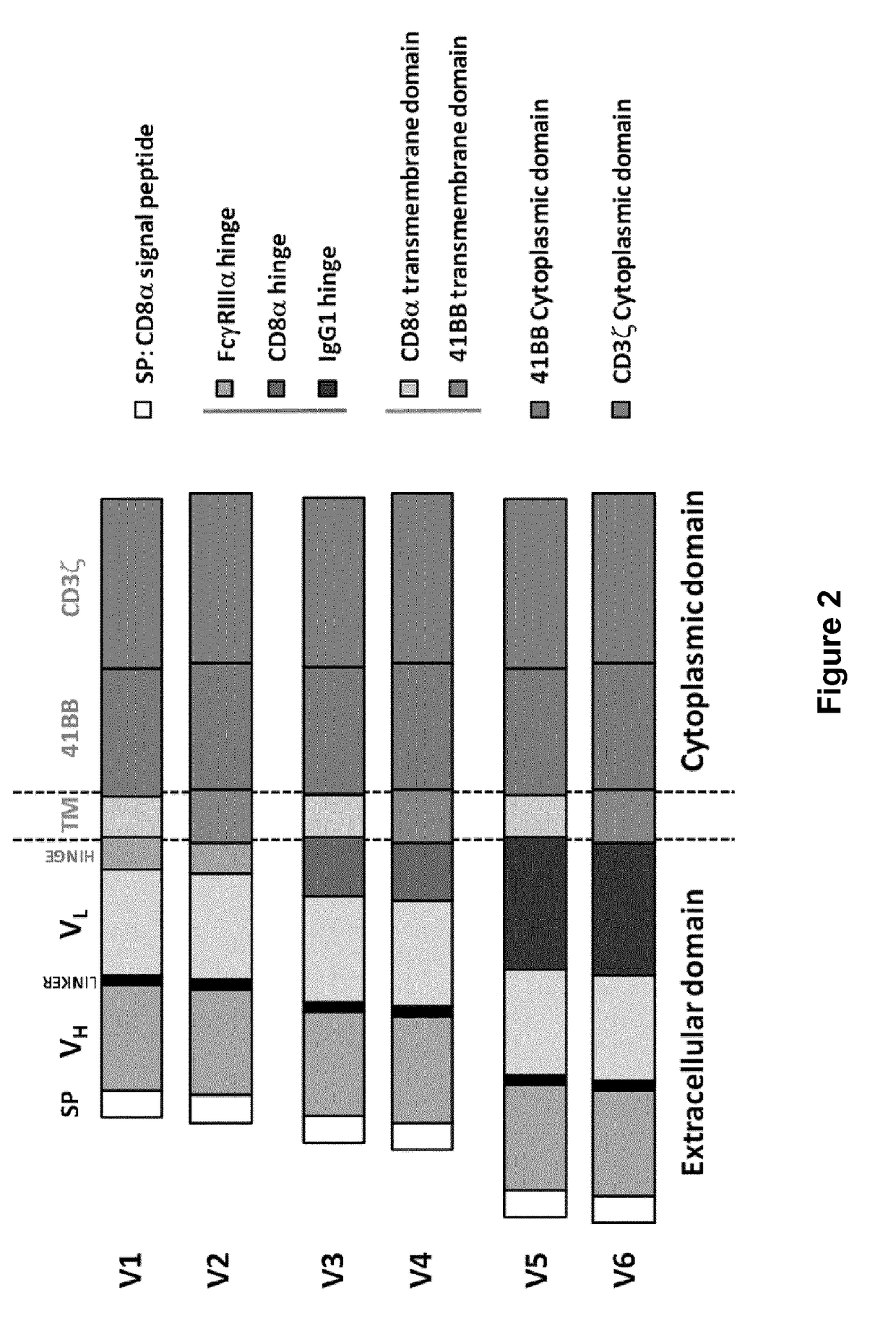Cd33 specific chimeric antigen receptors for cancer immunotherapy
a chimeric antigen receptor and cancer immunotherapy technology, applied in the field of chimeric antigen receptors, can solve the problems of inability to provide prolonged expansion and anti-tumor activity in vivo, cannot be expanded to any antigen, and the treatment is relatively toxic to the patien
- Summary
- Abstract
- Description
- Claims
- Application Information
AI Technical Summary
Benefits of technology
Problems solved by technology
Method used
Image
Examples
example 1
Proliferation of TCRalpha Inactivated Cells Expressing a CD33-CAR
[0401]Primary T-Cell Cultures
[0402]T cells were purified from various buffy coat samples provided by EFS (Etablissement Francais du Sang, Paris, France) using Ficoll gradient density medium. The PBMC layer was recovered and T cells were purified using a commercially available T-cell enrichment kit (Stem Cell Technologies). Purified T cells were activated in X-Vivo™-15 medium (Lonza) supplemented with 20 ng / mL Human IL-2, 5% Human Serum, and Dynabeads Human T activator CD3 / CD28 at a bead:cell ratio 1:1 (Life Technologies). After activation cells were grown and maintained in X-Vivo™-15 medium (Lonza) supplemented with 20 ng / mL Human IL-2 and 5% Human Serum.
[0403]CAR mRNA Transfection
[0404]Transfections of each CD33 CAR generated using various anti-CD33 antibody fragments were done at Day 4 or Day 11 after T-cell purification and activation. 5 million cells were transfected with 15 μg of mRNA encoding the different CAR co...
example 2
Inactivation of the CD33 Gene
[0414]To inactivate the CD33 gene, heterodimeric TALE-nuclease targeting two sequences (called Sequence bound by TALEN Left and Sequence bound by TALEN Right, see table 11) separated by a 10 or 15-bp spacer within CD33 gene were designed and produced as described below. Each half target is recognized by repeats of the half TALE-nucleases listed in Table 11. The constructs were then introduced into T cells together with and at the same time that those designed to inactivate the TCR alpha gene.
TABLE 11 TAL-nucleases targeting TCRaIpha geneTargetTarget sequencesTALEN1_CD33_Exon3TGCATCCCCTCTTTCTCCTCACTAGACTTGACCCACAGGCCCAA (SEQ ID NO: 72)TALEN2_CD33_Exon3TTCTCCTCACTAGACTTGACCCACAGGCCCAAAATCCTCATCCCTGGCA (SEQ ID NO: 73)TALEN1_CD33_Exon4TCCTCTCCTAGATGTTCCACAGAACCCAACAACTGGTATCTTTCCAGGA (SEQ ID NO: 74)TALEN2_CD33_Exon4TCCTAGATGTTCCACAGAACCCAACAACTGGTATCTTTCCAGGA (SEQ ID NO: 75)Sequence boundSequence bound by TALEN LeftSpacerby TALEN RightTGCATCCCCTCTTTCTC CTCAC...
example 3
[0420]Degranulation Activity of CD33 CAR Generated Using Various Anti-CD33 Antibody Fragments
[0421]The activity of the constructs V1, V3 and V5 of M195, m2H12 and My9.6 as described above was first determined upon transient expression in human primary T-cells.
[0422]Degranulation Assay (CD107a Mobilization)
[0423]T-cells were then incubated in 96-well plates (40,000 cells / well), together with an equal amount of cells expressing various levels of the CD33 protein. Co-cultures were maintained in a final volume of 100 μl of X-Vivo™-15 medium (Lonza) for 6 hours at 37° C. with 5% CO2. CD107a staining was done during cell stimulation, by the addition of a fluorescent anti-CD107a antibody at the beginning of the co-culture, together with 1 μg / ml of anti-CD49d, 1 μg / ml of anti-CD28, and 1× Monensin solution. After the 6 h incubation period, cells were stained with a fixable viability dye and fluorochrome-conjugated anti-CD8 and analyzed by flow cytometry. The degranulation activity was deter...
PUM
| Property | Measurement | Unit |
|---|---|---|
| temperature | aaaaa | aaaaa |
| volume | aaaaa | aaaaa |
| polypeptide structure | aaaaa | aaaaa |
Abstract
Description
Claims
Application Information
 Login to View More
Login to View More - R&D
- Intellectual Property
- Life Sciences
- Materials
- Tech Scout
- Unparalleled Data Quality
- Higher Quality Content
- 60% Fewer Hallucinations
Browse by: Latest US Patents, China's latest patents, Technical Efficacy Thesaurus, Application Domain, Technology Topic, Popular Technical Reports.
© 2025 PatSnap. All rights reserved.Legal|Privacy policy|Modern Slavery Act Transparency Statement|Sitemap|About US| Contact US: help@patsnap.com



